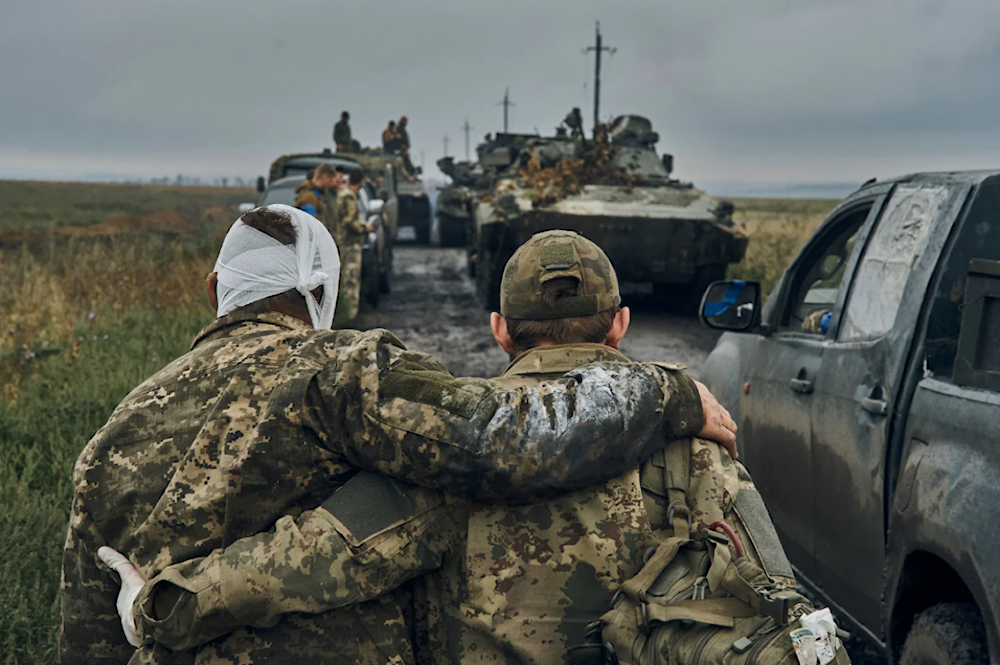No breaks or rotation; Ukraine's war drafting saga continues
In September, Ukrainian media reported that almost nine out of every ten Ukrainian draftees who enlisted in the army have either been killed or injured in combat.
-

Ukrainian troops on the road in Kharkov on Sept. 12, 2022 (AP)
Two years after the war in Ukraine began, and as the Ukrainian army faces numerous hurdles, the Financial Times has reported on what Ukrainian troops call fading motivation and low morale.
A Ukrainian soldier expressed that their motivation was being "killed" on the battleground due to the two years of constant war with no rotation or breaks.
That is one of many reasons, the soldier noted, why men are avoiding being drafted to the frontlines.
A new mobilization legislation, set to be voted on by parliament on March 31, aims to revamp the country's legislative framework in front of a possible recruiting surge this year that might include up to 500,000 individuals. An estimated 330,000 troops are presently engaged on the battlefield.
In September, Ukrainian media reported that almost nine out of every ten Ukrainian draftees who enlisted in the army have either been killed or injured in combat.
The draft would strive to modernize recruiting and training. However, the bill is proving contentious, with more than 4,000 revisions proposed by Ukrainian MPs on the first draft.
Read more: UK mercenary who fought in Ukraine commits suicide upon return home
Two years after the war began, Ukraine's volunteers were running out and a considerable number of men of combat age refused to be dispatched to the front. So far, only males aged 27 and above have been recruited, with those serving on the battlefield being average in their forties. Ukraine also has a smaller pool of millennials and Generation Z than other countries.
President Volodymyr Zelensky announced last month that a total of 31,000 have died, while experts say the true number is far higher.
According to data supplied by the parliamentary economics committee, of 11.1 million Ukrainian males aged 25 to 60, only an estimated 3.7 million are qualified for mobilization. The others are fighting, handicapped, overseas, or deemed important workers.
Ukraine to be divided between those who fight and those who work
Since 2022, males aged 27 to 60 have been prohibited from leaving the nation, with a few exceptions for medical reasons or sole caregivers of children or impaired family members. According to an Info Sapiens survey, concerns about insufficient training, an unknown duration of duty, and a shortage of weapons and ammunition were the major driving forces behind those avoiding fighting.
The new mobilization law aims to resolve these concerns. The original draft suggests a three-year service term and a minimum of three months of training.
The new law aims to decrease the mobilization age by two years, to 25, something met with harsh criticism by opponents who believe the war is a dead end and thus a death sentence for the younger population.
Ukraine already has 550,000 to 700,000 key workers who are excluded from mobilization and under the new arrangement, they will be required to contribute financially to the war effort, either through a portion of their wages or a monthly tax. Prime Minister Denys Shmyhal has thus far declined to provide specifics but has stated that "people should be divided into two categories: those who fight [and] those who work to fill the budget."
Oleksandr Zavitnevych, head of the parliamentary defense committee, warned of fear that the society would be divided into rich and poor due to the bill, cautioning that there should be "wide discussion" regarding the matter.
How fragile are Ukraine's defense lines?
Newsweek recently reported, citing military sources, that the recent capture of Avdiivka has been followed by the continuous expansion of Russian control along the frontlines.
According to the source, Ukrainian forces are "both outmanned and outgunned along the front." The recent fall of Avdiivka was in part blamed on ammunition shortages.
Since then, Russia's expansion has been "incremental" and will likely increase in the short term as long as aid remains stalled in the West.
According to the arms-maker-funded Institute for the Study of War, the victory in the battle of Avdiivka has opened new avenues for land control in surrounding areas, and Russian forces are working rapidly to increase their presence along the frontlines before Ukrainian forces rebuild a more cohesive defense line.
Last week, Dmytro Lykhovyi, spokesperson for the Ukrainian Tavriisk Group of Forces, announced that his troops had pulled back from Stepove, approximately eight miles north of Avdiivka. Russian troops, on the other hand, declared control of Tonenke to the south, along with other nearby territories.

 5 Min Read
5 Min Read









